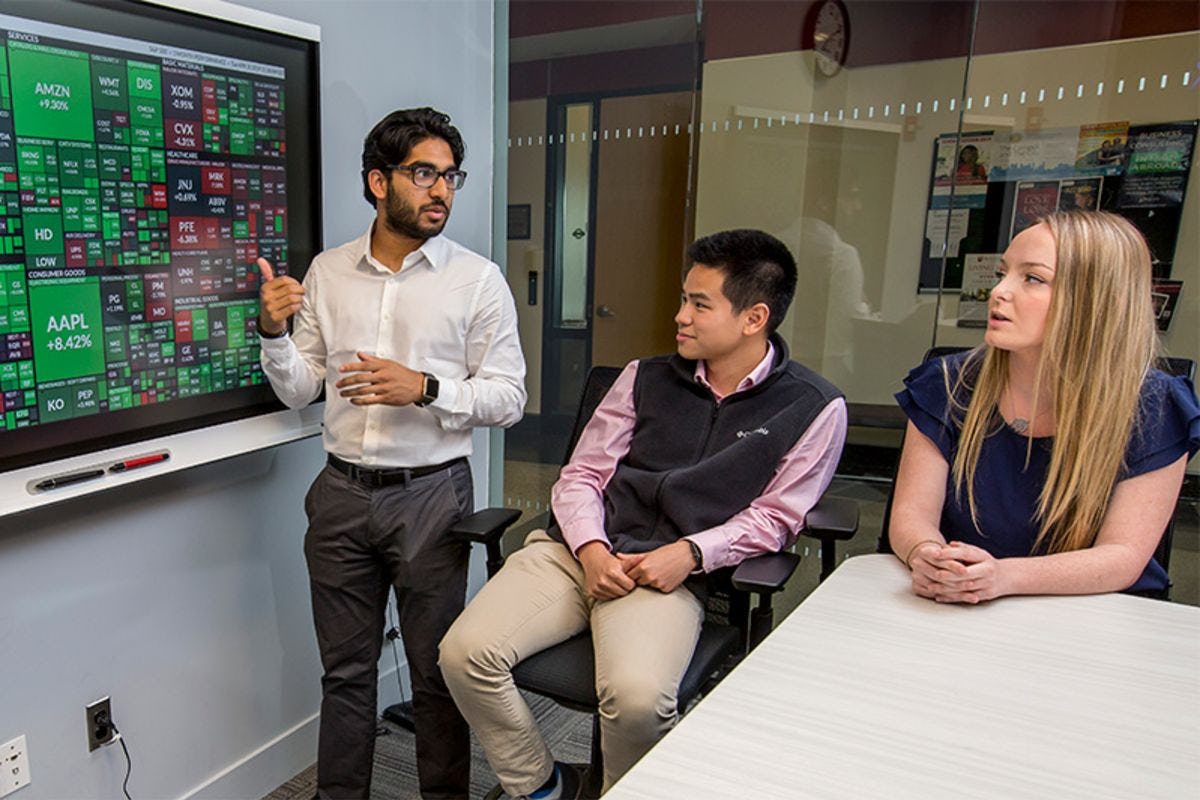Stevens Celebrates 10-Year Anniversary of the Hanlon Financial Systems Center
The Hanlon Financial Systems Center, which opened April 17, 2012, is the result of a gift to Stevens from benefactors Sean and Cathy Hanlon. Sean, a Stevens Trustee and Alumnus, had a vision for a state-of-the-art financial technology and teaching center to create a dynamic connection between financial theories and real-world practices.
Last month, Stevens Institute of Technology celebrated the 10-year anniversary of the opening of the Hanlon Financial Systems Center (HFSC), which opened April 17, 2012. The HFSC, which originally contained one lab but in 2016 grew to include another important lab, is the result of a gift to Stevens from benefactors Sean and Cathy Hanlon. Sean, a Stevens Trustee and Alumnus, had a vision for a state-of-the-art financial technology and teaching center to create a dynamic connection between financial theories and real-world practices. The HFSC and associated labs integrate the latest hardware and software technology, accessing real-time data and historical data, supporting innovative research into the most common and urgent problems in contemporary finance.
Aerial view of the Stevens campus in Hoboken, NJ, across the Hudson River from Manhattan.
The Hanlon Lab for Financial Analytics and Data Visualization is unique in a university setting for its deployment of the same technology used by major Wall Street firms. Students use these tools to analyze and visualize large datasets in real-time preparing them to use this technology to drive better informed decision making. State-of-the-art tools in these labs power faculty inquiries into risk management, innovation adoption, asset valuation, regulation, technology strategy, algorithmic trading, cognitive computing and cybersecurity. This high-tech facility commands an incredible view of New York City.
“The Hanlon gift enables us to train so many generations of students at all levels — bachelor's, master's, and Ph.D.,” says Ionut Florescu, director of the Hanlon Center. “I am most proud of our lab assistant alumni who are today, without exception, in so many lucrative positions in New York City and all over the world.”
With 60 to 70 classes offered each year including the summer, the school takes full advantage of the lab resources. Students are trained in valuable skills related to programming, databases, writing, parallel computing and more. The courses and research use Bloomberg terminals and Wharton Research Data Services (WRDS) to access financial data provided by the primary data providers in the fintech world including Refinitiv, Thomson Reuters, S&P Capital, Markit, and CRSP.
Professor George Calhoun, executive director of the HFSC, who leads instruction and facilitates the overall direction of the HFSC stated, “The HFSC provides a unique learning opportunity. For the past 10 years this facility has provided access to new educational opportunities for students creating a meaningful impact for the university.”
Focal Point
Sean Hanlon interviewed by Bloomberg in the Hanlon Financial Systems Center.
When it was launched, the HFSC set out to be a focal point in academia and industry for research of finance technology and financial systems, and their applications in business. What began as an educational initiative has transformed into a sophisticated fintech education incubator which continues to grow and develop to meet the needs for students at one of most desirable STEM colleges in the nation.
Gregory Prastacos, Dean of the School of Business at Stevens Institute of Technology since 2012, has brought an inspirational vision on the union of finance and analytics. This shared enthusiasm for fintech made The HFSC essential to the success and growth of the School of Business. “Sean has demonstrated a commitment to growth in the financial education sector. Sean’s passion, expertise and entrepreneurial spirit in fintech has opened doors for meaningful partnerships and relationships for the entire university. His energy, leadership and contribution have been essential to our growth and cannot be understated.”
At the School of Business, master’s degrees in both financial engineering and financial analytics and all the graduate programs in finance and quantitative finance rely on the resources of the HFSC for curriculum completion. The HFSC is core to the Ph.D. program for financial engineering, data science and business administration.
A student investment team collaborates on a project.
The HFSC also aided in the School of Business gaining its AACSB accreditation in 2015 and has already achieved No. 77 on the 2021 US News Best Business Schools list. The innovative energy directed toward fintech education is one of the primary reasons for the business school’s success. At Stevens, where quantitative finance and cybersecurity became two of the hottest, highly sought-after majors five years ago, the growth has compounded for the university. Enrollment is up 28% and SAT scores went up over 50 points, improving admission rates by 15% from a decade ago. Ninety-five percent of graduates secure full-time employment or enter a graduate program. Recruitment has been impressive from Goldman Sachs, Google, Johnson & Johnson, Verizon and many other world-class employers.

Executive Director George Calhoun teaching a class in quantitative finance.
This hub of thinkers around fintech has fostered an environment that has inspired interest from business, educational and governmental sectors. The opening of the Center for Research toward Advancing Financial Technologies (CRAFT) at Stevens in October 2021 has the distinct honor of being the first fintech research center backed by the National Science Foundation (NSF). During CRAFT’s launch meeting, more than 40 financial industry leaders, startups, universities and government agencies gathered to discuss financial research, technology development, workforce development and the impact of financial technology on commerce and society.
Directed by Steve Yang and George Calhoun, CRAFT has also captured the attention and collaboration of major NYC area companies like JP Morgan, Bank of America, UBS, Morgan Stanley, Goldman Sachs, Wells Fargo, and dozens more. Stevens continues to actively lead the conversation on fintech.
The anniversary of the HFSC at Stevens represents a milestone for innovative thought. Few other initiatives boldly explore the subject matter of cryptocurrency, blockchain technology, AI solution strategies and other contemporary financial technology topics.
“The launch of the Hanlon Financial Systems Center a decade ago was truly a pivotal point in the transformation of the School of Business at Stevens,” said Nariman Farvardin, president of Stevens. “The vision of Sean Hanlon, Dean Prastacos and the leaders of the HFSC have prepared thousands of Stevens students to be leaders in an industry that has been completely disrupted by technology. In addition, that vision is now creating innovative solutions to current and emerging problems faced by the financial industry.”





